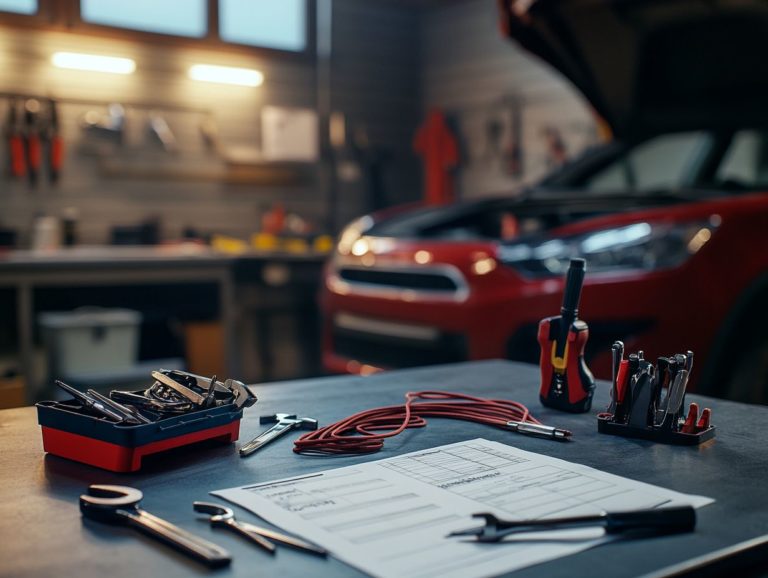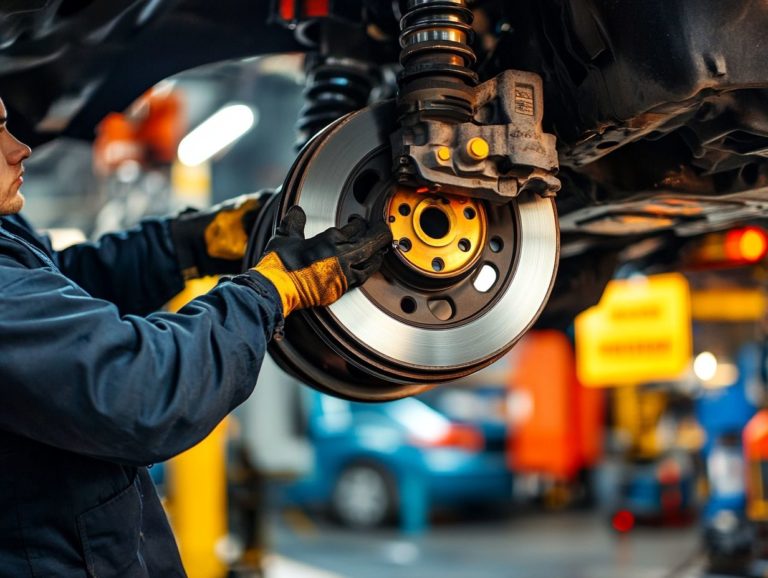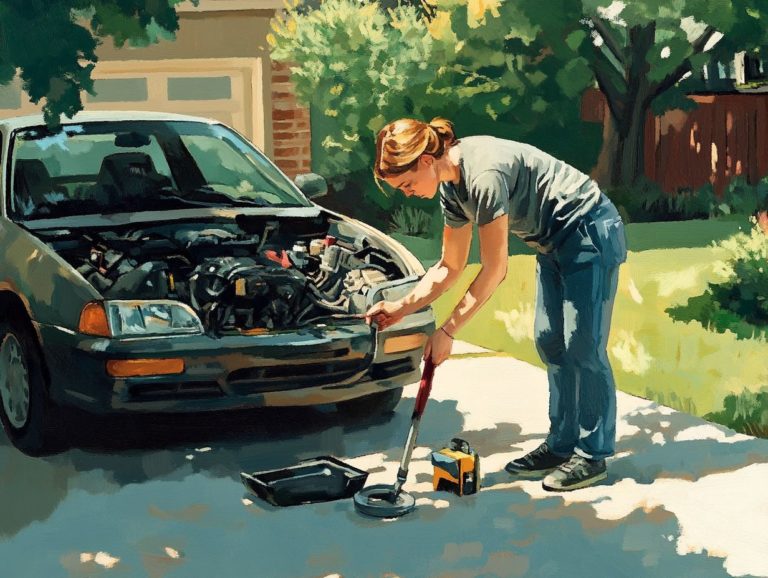Dealing with Common Tire Repair Issues
Tires are the unsung heroes of your vehicle, shouldering the weight of your journeys and ensuring a smooth ride. However, like any essential component, they can face various common issues that need your attention.
This article explores frequent tire repair problems, effective techniques like patching and plugging, and vital maintenance tips to prevent future mishaps.
You ll also discover what to do in emergencies, how to recognize when it’s time to call in the professionals, and how to select a trustworthy repair shop.
Buckle up! You re about to discover everything you need to keep your tires in top shape!
Contents
Key Takeaways:

- Regular tire maintenance and rotations can prevent common repair issues like uneven wear and punctures.
- Knowing how to change a flat tire and handle a blowout can save you from dangerous situations.
- When in doubt, seek professional help for serious tire damage and choose a reliable repair shop for quality service.
Common Tire Repair Issues
Common tire repair issues affect many vehicle owners and can significantly impact your driving safety, vehicle performance, and the overall durability of your tires. Knowing how to deal with common tire blowouts can help you address challenges like uneven wear, punctured tires from nails or glass, and flat tires, which often arise from inadequate maintenance or external factors like potholes.
Regular tire inspections are essential for spotting potential issues early, ensuring your tires remain in optimal condition. By understanding these common tire problems, you can save both time and money while significantly enhancing your driving experience.
Overview of Common Problems
When considering tire performance, it s crucial to understand issues like uneven wear, tire punctures, and blowouts. This knowledge can greatly enhance your vehicle’s safety.
If these problems go unaddressed, you could see a troubling decrease in handling stability, longer braking distances, and an increased risk of accidents.
Uneven wear typically shows up as a tread pattern that lacks uniformity across the tire’s surface, often due to wheels being improperly aligned or inflated incorrectly. Tire punctures can occur from road debris or sharp objects, leading to an immediate loss of pressure that jeopardizes your control while driving.
A blowout often caused by prolonged wear and overheating can lead to sudden tire failure. It s essential to regularly inspect your tires for early warning signs.
By addressing these issues promptly, you not only improve vehicle performance but also ensure the safety of everyone on the road.
Tire Repair Techniques
Tire repair techniques include methods such as patching, plugging, tire rotation, and balancing. Each is essential for ensuring optimal tire performance and longevity.
When executed correctly, these techniques can significantly extend the life of your tires and improve handling, allowing them to perform admirably in various driving conditions.
Tire specialists recommend regular maintenance to prevent common issues that could lead to expensive replacements down the line.
Patching and Plugging
Patching and plugging are two vital techniques for addressing a punctured tire, each with its distinct advantages and ideal applications. Understanding when to use each method is essential for effective tire maintenance.
Patching involves placing a piece of rubber over the damaged area from the inside, making it ideal for larger punctures found in the tread. This technique forms a robust seal and is often preferred for extending a tire’s life.
On the other hand, plugging is better suited for small punctures and can usually be done quickly from the outside.
When using tire repair kits, it s crucial to evaluate the severity of the damage during the inspection process. This careful assessment ensures you select the most effective repair method, ultimately enhancing your safety on the road.
Tire Rotation and Balancing
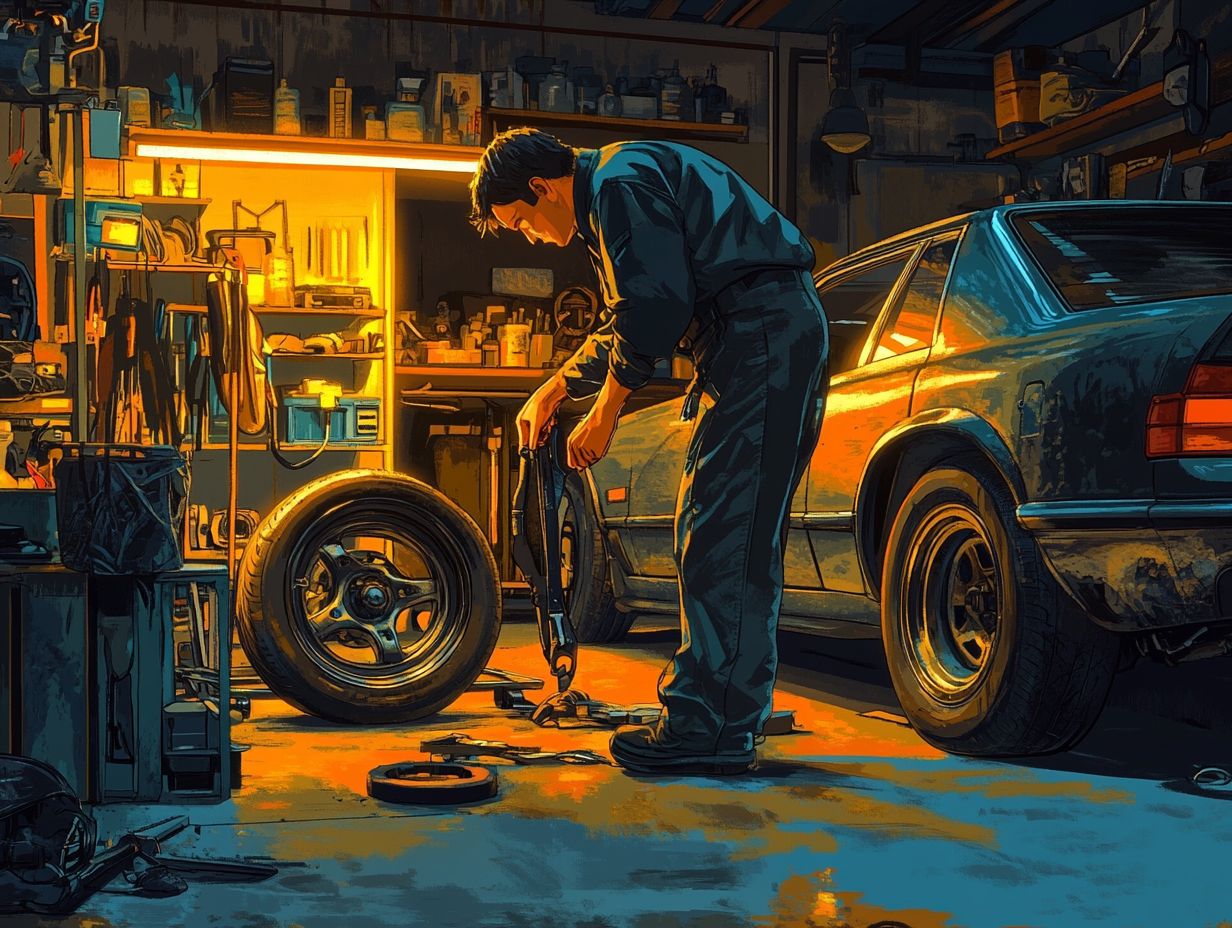
Tire rotation and balancing are essential parts of tire maintenance that can greatly influence uneven wear patterns and the overall lifespan of your tires.
By routinely attending to these tasks, you can significantly enhance your vehicle’s performance. This leads to improved handling and safer driving experiences. Regular tire rotation involves repositioning your tires. This ensures wear is distributed more evenly across all four tires. This practice prevents certain tires from wearing out faster than others, which is crucial for your safety and comfort.
Balancing ensures that the tire and wheel combination spins evenly, enhancing stability as you drive. For the best results, it’s recommended that you rotate your tires every 5,000 to 7,500 miles and check the balance during these rotations.
Follow these best practices to see incredible results! You not only extend the life of your tires but also boost fuel efficiency, making it a savvy investment for any driver.
Preventing Repair Issues
Taking proactive steps to prevent repair issues is crucial for ensuring your driving safety and maximizing your vehicle’s performance. Embracing regular tire maintenance practices like checking tire pressure, following a meticulous inspection checklist, and recognizing how driving conditions impact tire health can significantly decrease the chances of facing common tire problems.
By staying ahead of the curve, you can maintain proper tire inflation and sidestep those costly repairs or replacements down the road.
Tire Maintenance Tips
Implementing effective tire maintenance tips is essential for maintaining optimal tire performance and ensuring your safety on the road.
Regular checks can significantly extend the lifespan of your tires while also enhancing your riding comfort and fuel efficiency. For example, monitoring tire pressure is crucial. Underinflated tires not only wear out faster but also diminish your fuel economy.
Assessing tread depth is equally important. Worn-out tires can compromise your traction, particularly in wet conditions. Pay attention to proper wheel alignment to prevent uneven tire wear, which can create unsafe driving situations.
By taking these proactive measures, you can ensure your tires perform at their best. This ultimately safeguards yourself and other road users.
Dealing with Emergency Situations
Facing emergency situations like a flat tire or blowout demands your quick thinking and the right tools at hand, including a reliable tire repair kit and the know-how to change that flat tire. Grasp the correct steps to navigate these scenarios to safeguard your well-being. This also enables you to call for prompt roadside assistance if necessary.
Prepare now to tackle emergencies with confidence! This preparation can save valuable time and minimize stress while on the road.
Changing a Flat Tire
Changing a flat tire can be a remarkably straightforward task when you have the right tools and knowledge at your disposal, ensuring your safety throughout the process.
- Find a flat surface to park your vehicle, steering clear of traffic. Engaging the parking brake is crucial to prevent any unexpected movements while you re focused on the job.
- Once you’ve gathered your tire repair kit complete with a jack, wrench, and spare tire the initial step is to slightly loosen the lug nuts without removing them entirely.
- Next, position the jack under the vehicle s designated lifting point and elevate the car until the flat tire is off the ground. With the vehicle elevated, you can fully remove the lug nuts and take off the flat tire.
- Inspect the flat for any punctures or damage that might be repairable right there on-site, using your tire repair kit if necessary.
- Finally, remember to securely replace the spare tire and tighten the lug nuts in a star pattern for even distribution. This little detail ensures that your next drive is as smooth as possible.
Handling Blowouts
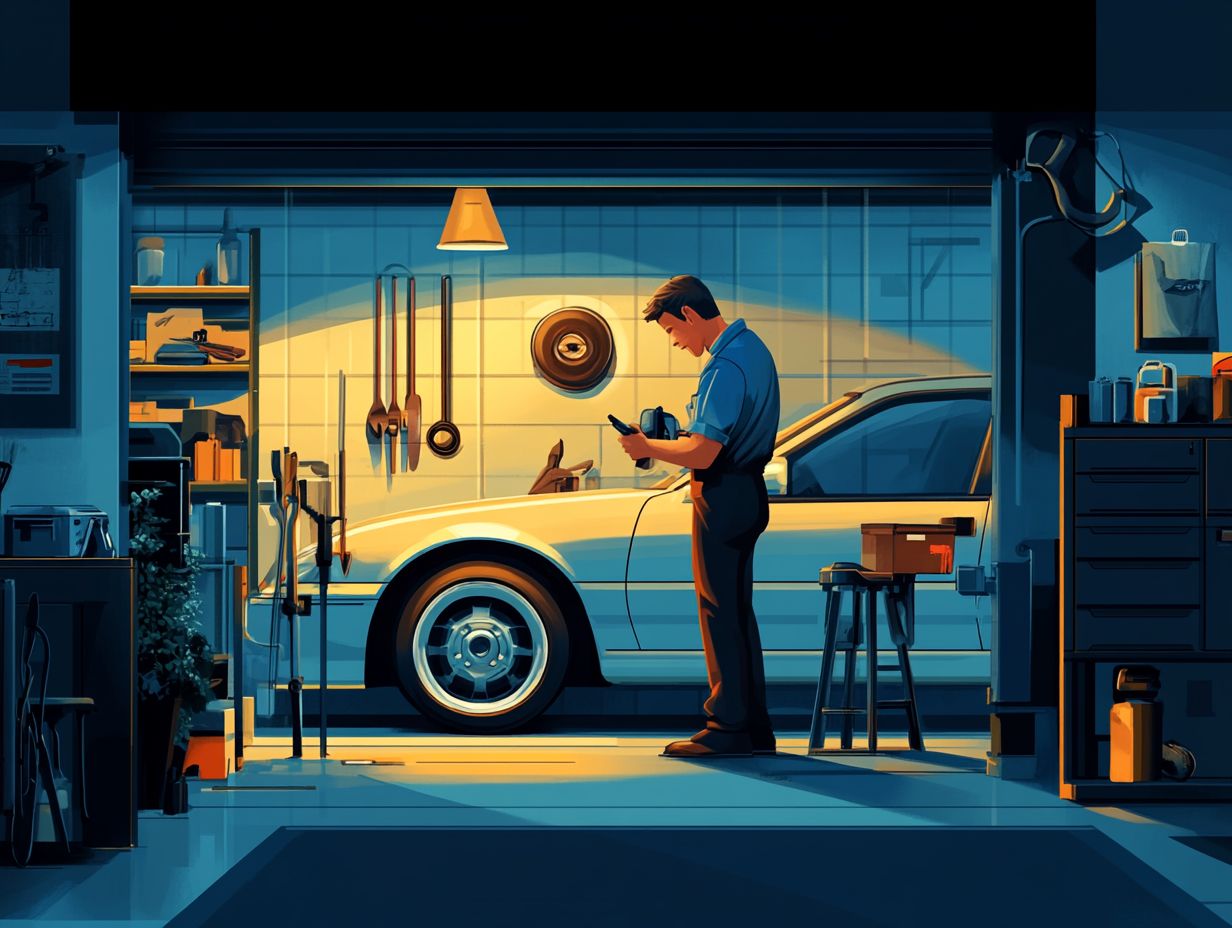
Handling blowouts effectively is essential for your driving safety. It requires prompt action to regain control of your vehicle.
When you find yourself in such an emergency, your first instinct should be to stay calm. Resist the urge for sudden steering or braking, as these actions can worsen the loss of control. Instead, gently ease off the accelerator to slow down gently. Steer straight and maintain a firm grip on the wheel. Guide your car towards a safe spot, like the shoulder of the road.
Remember that maintaining proper tire inflation can greatly diminish the chances of blowouts. Adequate tire pressure ensures even load distribution and enhances overall traction, paving the way for a safer driving experience.
When to Seek Professional Help
Recognizing the right moment to seek professional assistance for tire issues is crucial. It can prevent minor inconveniences from becoming serious safety hazards and enhance the longevity and performance of your tires.
If you see signs of serious tire damage like unusual wear patterns, severe sidewall damage, or a tire blowout get a professional to inspect your tires right away.
Being aware of your tire service history and the importance of regular inspections is vital for ensuring your driving safety.
Signs of Serious Tire Damage
Recognizing the signs of serious tire damage is essential for your safety on the road. Look out for unevenly worn tires and sidewall issues.
Check your tires regularly. This will help you spot dangerous issues early. For instance, bulges or blisters on the tire surface are warning signs of severe structural problems. Cracks in the sidewall can lead to a catastrophic blowout.
If you notice vibrations or unusual noises while driving, it may indicate internal tire issues that need your immediate attention.
Monitoring your tire pressure is also crucial. Underinflation not only accelerates wear but also increases the risk of damage. By staying vigilant about these signs, you can keep your tires in optimal condition, enhancing both your safety and the longevity of your tires.
Choosing a Reliable Repair Shop
Choosing a reliable repair shop is crucial for ensuring you receive quality tire service and prompt attention to any issues that arise.
A trustworthy establishment will handle your repairs and ensure your vehicle remains safe and efficient on the road. Start by reviewing the shop’s tire service history for insights into their expertise and the range of brands they typically work with.
Many modern repair services now offer mobile tire repair options, granting you the convenience of immediate assistance without the hassle of driving to a physical location. By considering these factors, you can secure a dependable repair experience that prioritizes both safety and efficiency.
Frequently Asked Questions
What are the most common tire repair issues?

The most common tire repair issues include punctures, leaks, wear and tear, and flat tires.
How can I prevent tire punctures?
Want to avoid tire punctures? Regularly check your tire pressure and tread depth, avoid driving over sharp objects, and keep your tires properly inflated.
What should I do if I have a tire leak?
If you have a tire leak, first check for any visible damage to the tire. If there is none, try using a tire sealant or patch kit to seal the leak. If the leak is too large or cannot be fixed, you may need to replace the tire.
How do I know if my tire needs to be replaced?
If your tire has significant wear, is constantly losing air, or has a puncture in an area that cannot be repaired, it may need to be replaced. Regularly check your tires for signs of wear and replace them when necessary for safety reasons.
Stay safe on the road check your tires today!
Can I repair a tire with a puncture?
In many cases, you can repair a tire with a puncture. It depends on the size and location of the damage.
Have a professional check the tire to see if it can be safely repaired or needs replacement.
What should I do if I have a flat tire?
If you have a flat tire, first pull over safely to change it. If you cannot do this, call for roadside assistance.
If you can change it yourself, follow proper safety procedures and replace the flat tire with a spare.
Act quickly! Have the flat tire repaired or replaced as soon as possible.

